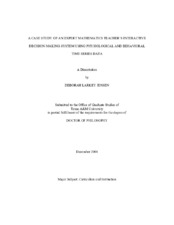| dc.contributor.advisor | Stuessy, Carol L. | |
| dc.creator | Jensen, Deborah Larkey | |
| dc.date.accessioned | 2005-02-17T21:02:20Z | |
| dc.date.available | 2005-02-17T21:02:20Z | |
| dc.date.created | 2004-12 | |
| dc.date.issued | 2005-02-17 | |
| dc.identifier.uri | https://hdl.handle.net/1969.1/1468 | |
| dc.description.abstract | The purpose of this exploratory case study was to describe an expert teacher’s decision-making system during interactive instruction using teacher self-report information, classroom observation data, and physiological recordings. Timed recordings of instructional interaction variables using an adapted Stallings Observation System were combined with simultaneous skin voltage measurements in time series analyses to describe observable and physiological elements of an expert teacher’s decision-making process. The mean and standard deviation of observable decision-action rates on teacher-identified “teaching days” were higher than the rates on “guiding” days. Bivariate time series analysis of decision-action rates and physiological response rates showed a significant positive relationship between the teacher’s decision-action rate and her physiological response rate on one teaching day. The positive relationship between the teacher’s decision-action rate and her physiological response rate was found to be context-dependent and related to the teaching strategy being used. High decision-action rates during direct instruction were associated with high physiological response rates compared to lower decision-action rates and physiological response rates while monitoring independent seatwork during a test. Correlation analysis of physiological
response rates with time revealed slight, but statistically significant negative trends for four of the five observation days. Major features of the teacher’s decision-making system included focusing attention on academic instruction with the use of routines for managing students and materials to perform teaching tasks; both proactive and reactive improvisational decisions; and physiological events characteristic of autonomic nervous system activity during instructional sequences of high teacher-student interactivity. Damasio’s Somatic Marker Hypothesis (Damasio, 1999) is offered as an explanation for the generation of specific characteristics of the expert teacher’s instruction, such as the high frequency of decision-actions and automaticity of appropriate decisions. | en |
| dc.format.extent | 9703461 bytes | en |
| dc.format.medium | electronic | en |
| dc.format.mimetype | application/pdf | |
| dc.language.iso | en_US | |
| dc.publisher | Texas A&M University | |
| dc.subject | decisions | en |
| dc.subject | time series | en |
| dc.subject | physiology | en |
| dc.subject | behavioral | en |
| dc.title | A case study of an expert mathematics teacher's interactive decision-making system using physiological and behavioral time series data | en |
| dc.type | Book | en |
| dc.type | Thesis | en |
| thesis.degree.department | Teaching Learning and Culture | en |
| thesis.degree.discipline | Curriculum and Instruction | en |
| thesis.degree.grantor | Texas A&M University | en |
| thesis.degree.name | Doctor of Philosophy | en |
| thesis.degree.level | Doctoral | en |
| dc.contributor.committeeMember | Loving, Cathleen C. | |
| dc.contributor.committeeMember | Knight, Stephanie L. | |
| dc.contributor.committeeMember | Willson, Victor | |
| dc.type.genre | Electronic Dissertation | en |
| dc.type.material | text | en |
| dc.format.digitalOrigin | born digital | en |


